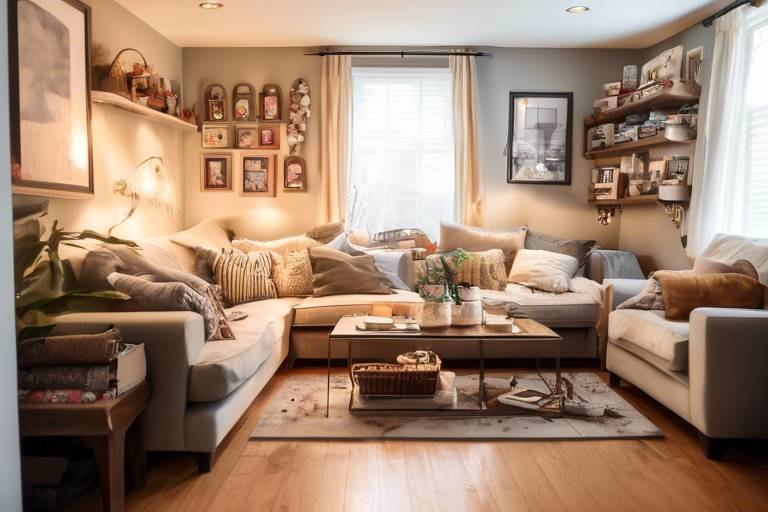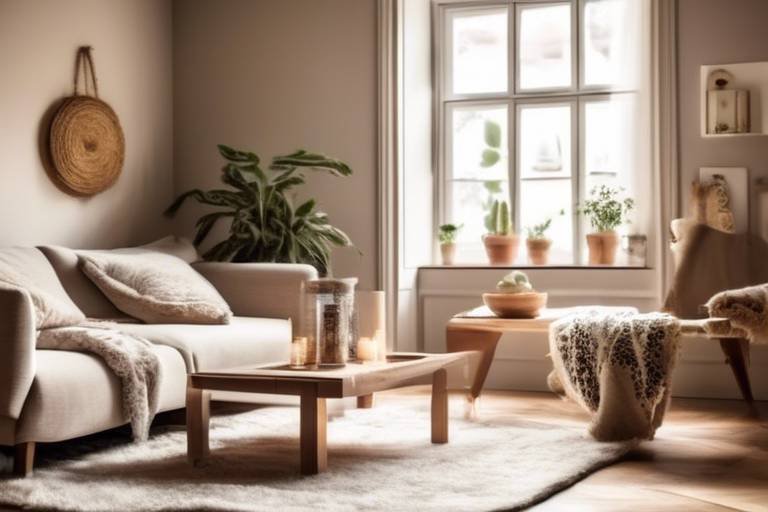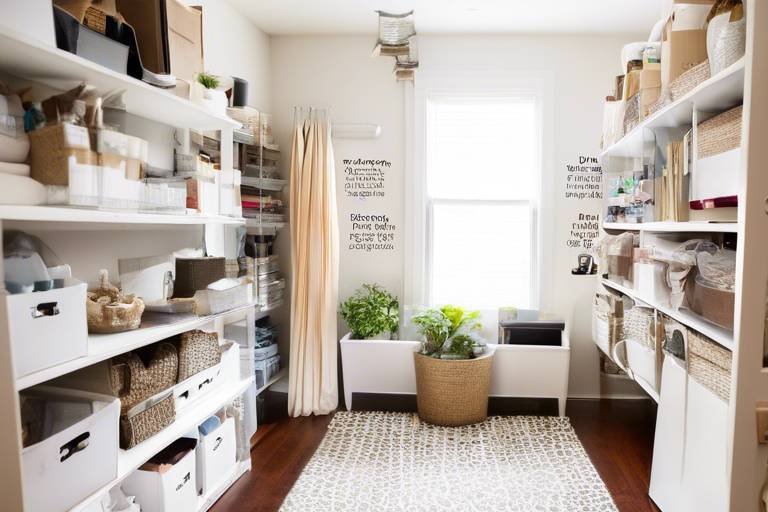Creating a Study-Friendly Home Environment
In today's fast-paced world, creating a study-friendly home environment is more crucial than ever. It’s not just about having a desk and a chair; it’s about crafting a space that inspires focus and fosters creativity. Imagine walking into a room that feels like a sanctuary, where every item is in its place, and the atmosphere whispers, "Let’s get to work!" This article explores how to design a conducive study environment at home, focusing on organization, comfort, and minimizing distractions to enhance productivity and learning effectiveness.
Having a dedicated study space is like having a secret weapon in your academic arsenal. When you step into this space, your brain knows it’s time to switch gears from leisure to learning. This psychological separation is vital; it helps you to focus better and makes it easier to dive into complex subjects without distractions. Think of it as your personal command center, where every book and tool is at your fingertips, ready to assist you in conquering your studies.
The location of your study space can significantly impact your concentration and efficiency. When selecting the best spot in your home for studying, consider factors like noise levels, lighting, and even the temperature. A quiet nook away from the hustle and bustle of daily life can work wonders for your focus. Conversely, a noisy area might leave you feeling frazzled and frustrated. So, where should you set up shop?
Natural light and proper ventilation are game-changers when it comes to creating an optimal study environment. Studies have shown that exposure to natural light can boost your mood and alertness, making you more productive. Imagine sitting at your desk, sunlight streaming through the window, energizing you as you tackle your assignments. Pair that with fresh air circulating in the room, and you have a recipe for success. So, if possible, try to position your study area near a window to soak up those vital rays!
Noisy environments can be a significant barrier to effective studying. To create a peaceful study zone, consider these strategies:
- Use noise-canceling headphones to block out background sounds.
- Play soft instrumental music or nature sounds to drown out distractions.
- Choose a room with thick carpets or curtains to absorb sound.
By taking these steps, you can transform your study space into a haven of concentration, allowing your mind to focus solely on your studies.
Personal touches can make your study space feel more inviting and comfortable. Think about adding items that inspire you, such as motivational quotes on the wall, colorful stationery, or even a plant to bring some life into the room. Personalization is not just about aesthetics; it’s about creating an environment that resonates with you. This connection can enhance your motivation and make studying feel less like a chore and more like a rewarding experience.
An organized study area promotes efficiency and reduces stress. Take a moment to think about how you currently store your books and supplies. Are they scattered everywhere, or do you have a system in place? Consider implementing the following organization tips:
- Use shelves or bookcases to keep books neatly stacked.
- Invest in storage bins for supplies like pens, highlighters, and notebooks.
- Utilize digital tools to keep your resources organized and accessible.
By streamlining your study materials, you can easily find what you need, allowing you to focus on what truly matters: your studies.
Comfort is crucial for prolonged study sessions. If you’re uncomfortable, your mind will wander, and your productivity will plummet. This is where ergonomic furniture comes into play. Investing in a good chair and desk can make all the difference in your study experience. You wouldn’t run a marathon without proper shoes, right? The same logic applies here: your study environment should support your efforts, not hinder them.
Selecting the right desk and chair can affect your productivity in more ways than one. Look for chairs that offer good lumbar support and desks that are at the right height for your comfort. You might even consider a sit-stand desk that allows you to switch positions throughout your study session. After all, a little variety can keep your mind fresh and engaged!
A distraction-free zone is essential for effective studying. To maintain concentration during study sessions, consider these techniques:
- Turn off notifications on your phone and computer.
- Set specific study times and communicate them to others to minimize interruptions.
- Keep your study area clean and clutter-free.
By implementing these strategies, you can transform your study area into a sanctuary of focus, allowing you to absorb information more effectively.
Q: How can I make my study space more comfortable?
A: Invest in ergonomic furniture, keep your space organized, and personalize it with items that inspire you.
Q: What should I do if my study space is too noisy?
A: Consider using noise-canceling headphones, playing soft music, or choosing a quieter location in your home.
Q: How can I stay motivated while studying at home?
A: Create a dedicated study space, set specific goals, and reward yourself after completing tasks.

Importance of a Dedicated Study Space
Have you ever tried to study in a noisy coffee shop or on the couch while binge-watching your favorite show? If so, you know how challenging it can be to focus. That’s where the concept of a dedicated study space comes into play. Creating a specific area in your home for studying can significantly enhance your ability to concentrate and absorb information. Think of it as your personal learning sanctuary, where distractions fade away, and productivity flourishes.
Psychologically, having a designated space for study helps to separate your study time from leisure activities. When you enter this space, your brain gets a cue that it’s time to switch gears. It’s like putting on your superhero cape; you know it’s time to get to work! This mental separation can lead to better focus and less procrastination, allowing you to dive into your studies with a clear mind.
Moreover, a dedicated study area can also lead to improved motivation. When you personalize your space with items that inspire you—like motivational quotes, plants, or even your favorite books—it creates an environment that encourages learning. It’s similar to how a musician might feel more inspired when surrounded by their instruments and sheet music. Your study space should evoke a sense of purpose and creativity, making you excited to hit the books.
Another significant benefit of having a dedicated study area is the potential for better time management. When you have a specific place to study, it becomes easier to create a routine. You can set specific hours for studying, just like you would for a job. Over time, this routine can enhance your overall academic performance, as you become accustomed to focusing during those dedicated hours. Just imagine the satisfaction of checking off completed tasks in your study planner!
In summary, a dedicated study space is not just a luxury; it’s a necessity for anyone serious about their academic success. By creating an environment that minimizes distractions, enhances motivation, and fosters better time management, you set yourself up for a more productive and enjoyable learning experience. So, why not take a moment to carve out your own little study haven? You might be surprised at how much more you can accomplish!
- Why is a dedicated study space important?
A dedicated study space helps to separate study time from leisure, enhancing focus and productivity. - How can I personalize my study area?
You can personalize your study space with inspiring quotes, plants, and items that motivate you. - What should I consider when choosing a study space?
Consider factors like natural light, noise levels, and comfort to create an optimal study environment.

Choosing the Right Location
When it comes to creating a study-friendly home environment, one of the most crucial factors to consider is the location of your study space. The right spot can make all the difference in your concentration levels and overall productivity. Imagine trying to focus on your studies while sitting in a noisy, cluttered area—it's like trying to read a book in a crowded café! To avoid such distractions, you need to find a place that not only suits your study habits but also enhances your ability to learn effectively.
First and foremost, think about proximity to distractions. Ideally, your study area should be away from high-traffic zones in your home, such as the living room or kitchen. If your family members are constantly moving around or engaging in loud activities, it can be nearly impossible to concentrate. Instead, consider a quiet corner of your home—perhaps a spare room, a basement, or even a nook in your bedroom. The key is to create a dedicated space that signals to your brain that it’s time to study.
Another important aspect to consider is access to resources. Your study location should be close to the materials and tools you need—like books, a computer, or even a printer. Having everything within arm's reach minimizes the chances of getting up and wandering off, which can lead to distractions. Picture this: you get up to grab a book and suddenly find yourself scrolling through your phone or chatting with a family member. To avoid this pitfall, organize your study area so that everything you need is at your fingertips.
Don’t forget about the atmosphere of your chosen location. The ambiance can significantly influence your mood and focus. A well-lit, tidy space can inspire creativity and motivation, while a dark, cluttered corner might make you feel sluggish and unmotivated. Aim for a location that offers a sense of calm and focus. You might even want to personalize it with items that inspire you, such as motivational quotes or your favorite artwork. This personal touch can transform a simple space into a sanctuary for learning.
Moreover, consider the temperature and comfort level of your study area. If it's too hot or too cold, your concentration will likely suffer. A comfortable environment can help you stay focused for longer periods. You might want to invest in a small fan or heater, depending on your needs, to maintain an optimal temperature. Think of your study space as your personal control center—everything should be just right to keep you engaged and productive.
Lastly, remember to assess natural light in your chosen study location. Natural light can have a profound impact on your mood and alertness. A space with ample sunlight can help you feel more awake and focused, while a dimly lit area might make you feel drowsy and unmotivated. If possible, position your desk near a window to take advantage of the sunlight. However, if that’s not feasible, consider using bright, warm artificial lighting to create a similar effect. Your goal is to cultivate a space that feels inviting and energizing.
In summary, choosing the right location for your study area is about finding a balance between comfort, accessibility, and minimal distractions. By thoughtfully selecting your study spot, you can create an environment that not only enhances your productivity but also makes studying a more enjoyable experience.
- What if I don’t have a quiet room available? If a dedicated room isn’t an option, try to carve out a small corner in a less-used area of your home. Use noise-canceling headphones or listen to soft instrumental music to drown out distractions.
- How can I make my study space more comfortable? Invest in an ergonomic chair and desk, and make sure your study materials are organized and within reach. Adjust the lighting to suit your preferences, and add personal touches that inspire you.
- Is it important to change my study location from time to time? Yes! Sometimes a change of scenery can refresh your mind and enhance creativity. If you find yourself getting bored or distracted, try studying in a different room or even outside.

Natural Light and Ventilation
When it comes to crafting the perfect study environment, natural light and ventilation are often overlooked yet critical elements. Imagine sitting at your desk, bathed in warm sunlight, with fresh air circulating around you. Doesn’t that sound like a recipe for productivity? Studies have shown that access to natural light can significantly boost your mood, enhance your concentration, and even improve your overall well-being. It’s like having a personal cheerleader encouraging you to dive into your studies!
But why is natural light so essential? Well, it’s not just about the aesthetics; it’s about the science behind it. Exposure to natural light helps regulate your body’s circadian rhythms, which in turn can lead to better sleep patterns and increased alertness during the day. Think of it as your body’s internal clock getting a much-needed tune-up. Conversely, a poorly lit room can lead to eye strain and fatigue, making it harder to focus on your studies.
Now, let’s talk about ventilation. A stuffy room can feel like a prison cell, and we all know how that can zap your motivation. Good ventilation ensures that fresh air flows into your study area, helping to keep your mind sharp and your energy levels up. It’s like having a breath of fresh air—literally! A well-ventilated room can improve cognitive function and reduce feelings of lethargy, making it easier for you to tackle those challenging study materials.
So, how can you maximize natural light and ventilation in your study space? Here are a few tips:
- Position Your Desk Wisely: Place your desk near a window to take advantage of the sunlight. Just be mindful of glare on your screen!
- Use Light Colors: Light-colored walls and furniture can help reflect natural light, making your space feel brighter and more open.
- Keep Windows Open: Whenever possible, open your windows to let in fresh air. If it’s too cold outside, consider using an air purifier to improve air quality.
- Incorporate Plants: Adding some greenery not only beautifies your space but also helps to improve air quality and create a calming atmosphere.
In conclusion, integrating natural light and proper ventilation into your study space is not just about comfort; it’s about maximizing your potential. By creating an environment that fosters focus and energy, you’re setting yourself up for success. So, next time you’re rearranging your study area, remember to let the sunshine in and keep the air flowing!

Minimizing Noise Distractions
Noise can be a formidable enemy when it comes to studying. Imagine trying to focus on a complex math problem while the TV blares in the background or your siblings are having a loud conversation. It’s enough to make anyone want to pull their hair out! To create a study-friendly environment, it’s crucial to implement strategies that help minimize these distractions. Here are some effective ways to achieve that:
First, consider the layout of your study space. Positioning your desk against a wall or in a corner can help reduce the impact of noise from other rooms. If possible, try to choose a location that is naturally quieter, away from high-traffic areas in your home. Think of it like finding your own little island of tranquility amidst a sea of chaos!
Next, you might want to invest in some soundproofing solutions. This doesn’t mean you have to turn your room into a fortress, but small changes can make a big difference. For instance, using heavy curtains can help absorb sound, while adding rugs can dampen noise from footsteps. You could also use weather stripping on doors and windows to block out external sounds. If you're feeling crafty, even adding some acoustic panels can enhance your space's sound quality.
Another effective technique is to use background noise to your advantage. Some people find that listening to soft music or white noise can drown out distracting sounds. There are plenty of apps and websites that provide ambient sounds, like rain falling or ocean waves, which can help create a calming atmosphere. Just be careful not to choose music with lyrics, as that can actually become a distraction in itself!
Finally, consider using noise-canceling headphones. They are a fantastic investment for anyone serious about studying. These headphones can block out unwanted sounds and allow you to focus solely on your work. Plus, they can be a great way to signal to others that you’re in “study mode.” Just remember to take them off during breaks to give your ears a rest!
In summary, minimizing noise distractions is all about creating an environment that promotes focus and productivity. By thoughtfully arranging your study space, utilizing soundproofing techniques, incorporating background noise, and investing in quality headphones, you can transform your study area into a peaceful haven. So, why not take these steps today and see how much more you can accomplish?
- What are some common sources of noise distractions while studying? Common sources include family conversations, television, traffic noise, and loud neighbors.
- How can I create a quiet study environment at home? You can create a quiet environment by choosing a secluded location for your study space, using soundproofing techniques, and incorporating background noise.
- Are noise-canceling headphones worth the investment? Yes, they can significantly help in blocking out distractions and enhancing your focus while studying.
- What type of background noise is best for studying? Soft instrumental music or ambient sounds like nature sounds are often the most effective for maintaining concentration.

Personalizing Your Study Space
When it comes to creating a study space that truly resonates with you, personalization is key. Think of your study area as a canvas waiting for your unique touch. By incorporating elements that reflect your personality and interests, you can transform a mundane corner into a vibrant sanctuary of learning. This not only makes the space more inviting but also boosts your motivation and creativity. Imagine walking into a space that feels like your own, where every detail inspires you to hit the books!
Start by considering the color scheme of your study area. Colors can significantly influence your mood and productivity. For instance, shades of blue can promote calmness and concentration, while yellows can energize and stimulate creativity. You might want to paint the walls or add colorful accessories that align with your preferences. Additionally, incorporating artwork or motivational quotes can serve as a daily reminder of your goals and aspirations. Why not hang up a framed picture of a place you dream of visiting or a quote that resonates with your journey?
Another way to personalize your study space is through the use of decorative items. Think about adding plants, which not only enhance the aesthetic but also improve air quality and boost your mood. A small succulent or a vibrant flower can bring a touch of nature indoors, making your study environment feel more alive. You might also consider displaying personal items, such as photos of loved ones or souvenirs from your travels, which can create a sense of comfort and connection while you study.
Furthermore, don't underestimate the power of organization in personalizing your space. Use stylish storage solutions that reflect your taste—whether it's a chic bookshelf, colorful bins, or a trendy desk organizer. This not only keeps your materials in order but also adds to the overall aesthetic of your study area. Imagine having a beautifully organized desk where everything you need is within arm's reach, making it easier to dive into your studies without the clutter.
Lastly, consider the technology you use. Personalizing your study space also means ensuring that your tech setup is tailored to your needs. Whether it's a comfortable keyboard, a high-quality monitor, or noise-canceling headphones, having the right technology can make a huge difference in your productivity. Set up your devices in a way that feels comfortable and efficient for you. After all, your study space should be a reflection of how you learn best!
In conclusion, personalizing your study space is all about creating an environment that feels uniquely yours. By incorporating colors, decor, organization, and technology that resonate with you, you can foster a learning atmosphere that not only enhances your focus but also makes studying a more enjoyable experience. So, roll up your sleeves and start transforming that corner of your home into a study haven that inspires and motivates you daily!
- How can I make my study space more comfortable?
Choose ergonomic furniture, adjust lighting to reduce glare, and maintain a clutter-free environment to enhance comfort. - What colors are best for a study space?
Colors like blue for calmness, yellow for energy, and green for balance are ideal for a productive study environment. - How can I minimize distractions while studying?
Turn off notifications, use noise-cancelling headphones, and create a clear boundary between study time and leisure time. - Should I decorate my study space?
Absolutely! Personal decorations can motivate you and make the space feel more inviting.

Organizing Study Materials
When it comes to studying effectively, organization is key. Think of your study materials as the tools of your trade; if they're scattered all over the place, it’s like trying to build a house without a blueprint. A well-organized study space not only saves time but also enhances your ability to absorb information. Imagine walking into a room where everything is in its place—books neatly stacked, notes sorted, and digital resources easily accessible. This kind of environment can significantly reduce stress, allowing you to focus on what truly matters: learning.
To start organizing your study materials, consider categorizing them based on subjects or topics. You might find it helpful to use different colored folders or binders for each subject. This visual cue can make it easier to locate materials quickly. For instance, you could use:
- Blue for Mathematics
- Green for Science
- Red for Literature
Additionally, don’t forget about digital organization! In today's tech-savvy world, most of us have a plethora of resources online. Create folders on your computer or in cloud storage that mirror your physical organization system. This way, whether you’re studying from a book or a digital resource, you’ll know exactly where to find what you need.
Another tip is to regularly declutter your study materials. Just like a gardener prunes their plants to encourage healthy growth, you should periodically sift through your notes and textbooks. Ask yourself: Are these materials still relevant? If not, it might be time to recycle or donate them. Keeping only what you truly need can free up space and make your study area more inviting.
Consider implementing a study schedule that allocates specific times for reviewing different subjects. By doing this, you can ensure that all your materials are prepped and ready for each session. It’s like having a game plan before a big match; you know what to expect, and you can prepare accordingly. You can even create a simple table to track your study sessions:
| Date | Subject | Materials Needed |
|---|---|---|
| 01/01/2024 | Mathematics | Textbook, Calculator, Notes |
| 01/02/2024 | Science | Lab Manual, Research Articles |
Ultimately, the goal is to create a study environment that feels comfortable and conducive to learning. By keeping your materials organized, you not only enhance your productivity but also cultivate a sense of accomplishment. So, take the time to set up your study materials properly; it’s an investment in your education that will pay off in spades!
Q: How often should I reorganize my study materials?
A: It’s a good idea to reorganize your materials at the beginning of each semester or whenever you feel overwhelmed. Regular decluttering helps keep your space efficient and stress-free.
Q: What’s the best way to store digital study materials?
A: Use cloud storage services like Google Drive or Dropbox to keep your digital files organized. Create folders for each subject and subfolders for topics or assignments to streamline access.
Q: How can I make my study materials more engaging?
A: Consider using colorful highlighters, sticky notes, or even digital tools like mind maps to make your study materials visually appealing and easier to remember.

Comfort and Ergonomics
When it comes to studying, comfort plays a pivotal role in maintaining focus and productivity. Imagine trying to concentrate on a complex math problem while sitting on an uncomfortable chair; it’s almost impossible, right? This is where ergonomics comes into play. Ergonomics is the science of designing a workspace that fits the user’s needs, ensuring comfort and efficiency. Investing in ergonomic furniture can be a game changer for your study sessions.
First off, let’s talk about posture. Good posture is essential not just for comfort but also for your overall health. Poor posture can lead to back pain, neck stiffness, and even long-term health issues. Therefore, it’s crucial to choose furniture that supports a natural posture. For instance, your chair should have adjustable height settings, allowing your feet to rest flat on the floor while keeping your knees at a 90-degree angle. A desk that is too high or low can cause strain, so finding the right height is essential.
Another important aspect of comfort is the material of your study furniture. Look for chairs with ample cushioning and breathable fabrics. A chair that feels like a rock after an hour of studying can quickly turn your study time into torture. You might want to consider chairs with lumbar support, which can help maintain the natural curve of your spine. Remember, comfort isn’t just a luxury; it’s a necessity for effective studying.
Now, let’s not forget about the desk. Your desk should not only be functional but also spacious enough to accommodate all your study materials without feeling cramped. A cluttered workspace can lead to a cluttered mind. You might want to opt for a desk with built-in storage solutions or use organizers to keep your materials handy yet out of the way. A clean, organized desk can significantly enhance your focus and productivity.
Additionally, consider the height of your desk and the type of work you’ll be doing. If you’re working on a laptop, you might want a desk that allows you to keep the screen at eye level to avoid neck strain. Some people even prefer standing desks or convertible desks that can be adjusted for sitting or standing. These options not only promote better posture but also allow for movement during long study sessions, which can help keep your energy levels up.
Incorporating breaks into your study routine is another ergonomic principle that can’t be overlooked. Just like a car needs fuel to keep running, your brain needs breaks to stay sharp. Consider using the Pomodoro Technique, where you study for 25 minutes and then take a 5-minute break. This not only helps maintain focus but also gives your body a chance to stretch and reset, reducing the risk of fatigue.
To sum it all up, creating a comfortable and ergonomic study environment is crucial for effective learning. By investing in the right furniture and being mindful of your posture, you can create a space that not only feels good but also promotes productivity. Remember, your study space is your sanctuary; treat it as such!
- What is the most important factor in a study space?
Comfort is key. A comfortable chair and desk can significantly improve your focus and productivity. - How often should I take breaks while studying?
Using techniques like the Pomodoro Technique can help; study for 25 minutes and take a 5-minute break. - Is ergonomic furniture really worth the investment?
Absolutely! Ergonomic furniture can prevent long-term health issues and make studying more enjoyable.

Choosing the Right Desk and Chair
When it comes to setting up your study space, the desk and chair you choose play a pivotal role in your overall productivity and comfort. Imagine trying to concentrate on your studies while perched on an uncomfortable chair that feels more like a medieval torture device than a supportive seat. Not exactly the ideal study environment, right? Therefore, selecting the right furniture is not just about aesthetics; it’s about creating a space that fosters focus and efficiency.
First and foremost, let's talk about the desk. Your desk should be spacious enough to accommodate your books, laptop, and any other study materials you need. Consider a desk that offers a minimum width of 48 inches, allowing ample space to spread out your materials without feeling cramped. Additionally, having drawers or shelves can help keep your study area organized, allowing you to easily access supplies without cluttering your workspace.
Now, let’s not forget about the chair. An ergonomic chair is essential for maintaining proper posture and avoiding fatigue during those long study sessions. Look for chairs that offer adjustable height, lumbar support, and comfortable cushioning. A chair that allows you to sit with your feet flat on the ground and your knees at a 90-degree angle can make a world of difference in how you feel after hours of studying.
Here are some features to consider when choosing your desk and chair:
- Height Adjustability: Both your desk and chair should be adjustable to fit your body type.
- Material: Choose durable materials that can withstand daily use. Wood and metal are popular choices.
- Mobility: If you like to change your study environment, consider furniture with wheels for easy relocation.
Moreover, the design of your desk and chair should complement your personal style and the overall aesthetic of your study space. Whether you prefer a modern look with clean lines or a more traditional style, having furniture that resonates with your personality can enhance your motivation to study. Think of it as creating your own little sanctuary where you can dive deep into your studies without distractions.
Ultimately, investing in the right desk and chair is an investment in your academic success. By prioritizing comfort and functionality, you’re setting yourself up for a more productive study experience. So, take the time to choose wisely, and you’ll find that the right setup can make studying not just bearable, but actually enjoyable!
1. How do I know if my desk height is correct?
The ideal desk height allows you to keep your elbows at a 90-degree angle while typing or writing, with your feet flat on the ground. If your desk is too high or too low, consider using a height-adjustable desk or adding a footrest.
2. What type of chair is best for long study sessions?
An ergonomic chair is best for long periods of sitting. Look for features like lumbar support, adjustable armrests, and breathable fabric to ensure comfort and prevent strain.
3. Should I invest in a standing desk?
If you find yourself sitting for long periods, a standing desk can be a great option. It allows for more movement, which can help reduce fatigue and improve focus. Just remember to alternate between sitting and standing to avoid fatigue.

Creating a Distraction-Free Zone
Creating a distraction-free zone is essential for effective studying. Imagine trying to concentrate on a complex math problem while your phone buzzes incessantly, or the TV blares in the background. It’s like trying to read a book in a crowded subway—almost impossible, right? To truly harness your focus and maximize productivity, you need to carve out a space that minimizes interruptions and fosters concentration. But how exactly can you achieve this?
First and foremost, declutter your space. A messy desk can be a significant source of distraction. Take a moment to remove unnecessary items that don’t contribute to your study goals. Keep only the essentials within arm's reach—your books, notebooks, and perhaps a cup of coffee. This not only helps clear your mind but also creates a visual cue that signals it’s time to study.
Next, consider the role of technology. While gadgets can be helpful, they can also be your worst enemy. Notifications from social media or emails can pull you away from your studies. To combat this, try using apps that block distracting websites during your study sessions. You can also put your phone on 'Do Not Disturb' mode or even leave it in another room. This way, you won’t be tempted to check it every few minutes, which can break your flow and derail your focus.
Another effective strategy is to establish a study routine. Just like any good habit, consistency can help train your brain to recognize when it’s time to focus. Set specific study hours and stick to them. During these times, inform those around you that you need uninterrupted study time. A simple sign on your door or a quick message to your family can go a long way in reducing interruptions.
Additionally, the environment itself plays a crucial role in minimizing distractions. Choose a quiet room away from high-traffic areas in your home. If you live in a noisy neighborhood, consider using noise-canceling headphones or playing soft instrumental music to drown out background noise. You could even experiment with white noise machines or apps that simulate calming sounds, like rain or ocean waves. These can help create a serene atmosphere conducive to concentration.
Finally, don’t underestimate the power of time management techniques. Techniques such as the Pomodoro Technique, where you study for 25 minutes and then take a 5-minute break, can help maintain your focus without feeling overwhelmed. During those brief breaks, step away from your desk, stretch, or grab a quick snack. This not only refreshes your mind but also keeps you from getting burned out.
In conclusion, creating a distraction-free zone is about more than just finding a quiet spot; it’s about cultivating an environment that supports your learning. By decluttering your space, managing technology, establishing a routine, optimizing your environment, and utilizing effective time management techniques, you can transform your study sessions from chaotic to productive. So, are you ready to take control of your study environment and boost your focus?
- What is the best way to minimize distractions while studying?
Decluttering your workspace, managing technology, and creating a routine can significantly help in minimizing distractions. - How can I create a comfortable study environment?
Choose a quiet location, use ergonomic furniture, and ensure good lighting to create a comfortable study environment. - Is it necessary to have a dedicated study space?
Yes, having a dedicated study space helps separate study time from leisure, enhancing focus and productivity.
Frequently Asked Questions
- Why is having a dedicated study space important?
Having a dedicated study space is crucial because it helps you mentally separate study time from leisure activities. This distinction can enhance your focus and productivity, making it easier to dive into your studies without distractions. Think of it as having a special zone where your brain knows it's time to work!
- What factors should I consider when choosing a study location?
When selecting the best spot for studying, consider factors like natural light, ventilation, and noise levels. A well-lit and airy space can boost your mood and alertness, while a quieter area minimizes distractions. Ideally, you want a spot that feels comfortable and conducive to concentration.
- How can I minimize noise distractions while studying?
To minimize noise distractions, try using noise-canceling headphones or listening to soft background music. You can also choose to study during quieter times of the day or use soundproofing techniques, like adding rugs or curtains, to absorb excess noise. Creating a peaceful atmosphere is key to staying focused!
- What are some tips for personalizing my study space?
Personalizing your study area can make it feel more inviting and motivating. Consider adding pictures, plants, or inspirational quotes that resonate with you. This personal touch not only enhances your comfort but can also spark your creativity and keep you engaged during study sessions.
- How should I organize my study materials?
Organizing your study materials is essential for efficiency. Use folders, binders, and digital tools to categorize your notes and resources. Keeping your space tidy and everything in its place allows you to find what you need quickly, helping you stay focused on your studies.
- What ergonomic features should I look for in a desk and chair?
When selecting a desk and chair, look for features like adjustable height, lumbar support, and a comfortable seat. An ergonomic setup can help you maintain good posture and prevent fatigue during long study sessions. Remember, comfort is key to staying productive!
- How can I create a distraction-free zone?
To create a distraction-free zone, set specific study hours and communicate these to those around you. Turn off notifications on your devices, and consider using apps that block distracting websites. By establishing clear boundaries, you can cultivate an environment that promotes concentration and productivity.



















